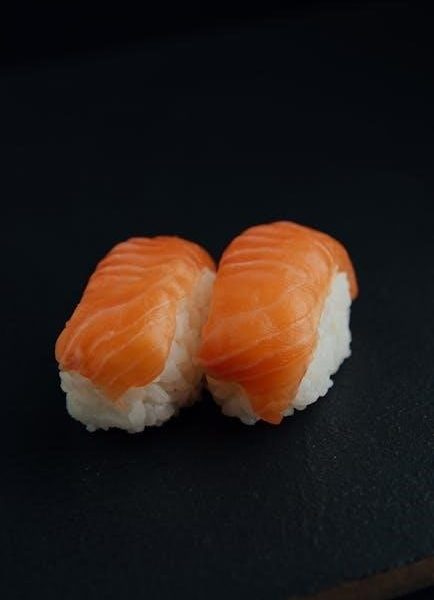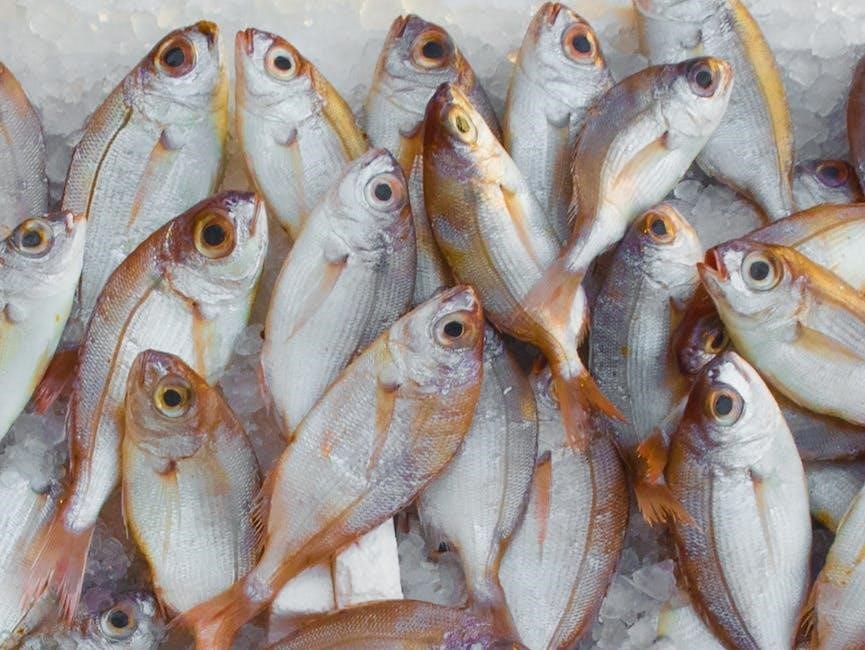
kosher fish list pdf
Kosher fish are species with fins and scales, adhering to Jewish dietary laws. This guide provides a comprehensive kosher fish list PDF, ensuring easy reference for adherence.
Definition and Basic Criteria
Kosher fish must have both fins and removable scales, as per Jewish dietary laws. Scales must detach easily without damaging the skin, and the fish must be identified whole. Processed or pre-packaged fish require certification. The kosher fish list PDF includes species like salmon, tuna, and mackerel, while excluding those without fins or scales. Authority bodies like the Orthodox Union (OU) and Chabad validate these criteria, ensuring adherence to kashrut standards. This guide simplifies identification for consumers seeking kosher options.
Key Organizations Providing Kosher Certification
Chabad and the Orthodox Union (OU) are leading authorities, offering reliable kosher certification. Their guidelines ensure adherence to dietary laws, as detailed in the kosher fish list PDF.
Chabad and Orthodox Union (OU) Guidelines
Chabad and the Orthodox Union (OU) provide stringent guidelines for kosher certification of fish. They ensure that each species meets the criteria of having fins and removable scales. The OU’s certification process involves rigorous inspections and verification, while Chabad focuses on educational resources. Both organizations publish detailed lists, including a kosher fish list PDF, to help consumers identify permissible species. These guidelines are widely trusted and followed in Jewish communities worldwide.
Other Reliable Certifications
Besides Chabad and OU, other trusted organizations like KOF-K, Star-K, and MK provide reliable kosher certification. These groups ensure fish meet kosher standards, including proper fin and scale criteria. Their certifications complement the kosher fish list PDF, offering additional layers of verification. These organizations are widely recognized and trusted, ensuring consumers can confidently purchase kosher-certified fish products. Their expertise and rigorous standards make them invaluable resources for adhering to Jewish dietary laws.
Comprehensive Kosher Fish List
This kosher fish list PDF provides a detailed guide, including common species like salmon, herring, and mackerel, ensuring adherence to Jewish dietary laws with verified criteria.
Common Kosher Fish Species
Popular kosher fish include salmon, cod, and herring, all featuring fins and removable scales. Salmon is widely consumed, often smoked or fresh, while cod and herring are staples in many dishes. These species are easily identifiable and widely available, making them common choices for kosher meals. Their inclusion in the kosher fish list PDF ensures they meet dietary standards, providing a reliable guide for consumers.
Less Common but Kosher Fish
Less common kosher fish include anchovies, angelfish, and barracudas, which also meet the fin-and-scale criteria. These species, while not as widely consumed, are still permissible under kosher dietary laws. Their inclusion in the kosher fish list PDF ensures consumers can identify and purchase them with confidence, even if they are less frequently found in markets. This diversity highlights the broad range of options available for those adhering to kosher standards.
Identifying Kosher Fish
Kosher fish must have removable fins and scales. The kosher fish list PDF simplifies identification, ensuring compliance with dietary laws by clearly outlining permissible species for consumption.
Physical Characteristics
Kosher fish must have both fins and scales that can be easily removed without tearing the skin. The scales must be visible to the naked eye and detachable. Fish without these features are non-kosher. For processed or filleted fish, reliable kosher certification is required, as physical characteristics may not be visible. This ensures adherence to dietary laws and maintains the integrity of kosher standards, as outlined in the kosher fish list PDF.
Verification Methods
Verification of kosher fish involves checking for fins and scales, which must be visible and easily removable. Consumers can visually inspect whole fish, while processed or filleted varieties require reliable kosher certification.Certification ensures adherence to Jewish dietary laws, guaranteeing the fish meets kosher standards. This method is crucial for maintaining compliance, especially when physical characteristics are not visible. The kosher fish list PDF often includes certified options, aiding consumers in making informed choices.

Smoked and Processed Fish
Smoked and processed fish require reliable kosher certification to ensure adherence to dietary standards. Examples include smoked salmon and trout, which must meet specific kosher criteria for consumption.
Certification Requirements
Smoked and processed fish must have reliable kosher certification to ensure compliance with dietary laws. Certification guarantees the fish meets kosher standards, including proper processing and packaging. For smoked fish, agencies like Chabad and OU verify adherence to kosher criteria. Processed fish, such as canned or pickled varieties, require strict supervision to avoid non-kosher additives. Without proper certification, even kosher fish species may be deemed non-compliant. Always check for recognized kosher symbols to ensure authenticity and adherence to Jewish dietary standards.
Popular Smoked Kosher Fish
Smoked salmon is a beloved choice, widely available and certified kosher by organizations like Chabad and OU. Smoked trout, with its delicate flavor, is another favorite. Mackerel and sardines are also popular, offering rich, smoky tastes. These fish are typically smoked to perfection and meet stringent kosher standards. They are perfect for bagels, salads, or as a snack, ensuring a delicious and compliant addition to any kosher meal.

Regional Availability of Kosher Fish
Regional availability of kosher fish varies globally. Common species like salmon and cod are widely accessible, while less common fish may require importing from other regions.
Global Variations
Kosher fish availability varies significantly across regions due to local species and dietary preferences. In Europe, cod and haddock are common, while in the Americas, salmon and tilapia prevail. Asian markets often feature carp and mackerel, reflecting regional tastes. Africa offers Nile tilapia and mullet, while Australia and the Middle East have unique species. These global variations are documented in detailed kosher fish list PDFs, ensuring consumers can identify permissible options worldwide. This diversity highlights the adaptability of kosher dietary practices.
Local vs. Imported Options
Local and imported kosher fish options vary based on regional availability and consumer demand. Locally sourced fish often offer freshness and lower costs, while imported options provide diversity. For instance, Europe favors cod and haddock, whereas the Americas prefer salmon. Importing allows access to global species, catering to cultural preferences. Both options require reliable certification to ensure kashrut compliance. This duality is detailed in kosher fish list PDFs, helping consumers make informed choices aligned with their dietary needs and preferences.
Non-Kosher Fish
Non-kosher fish lack fins or scales, such as sharks and rays. They do not meet the criteria outlined in Jewish dietary laws.
Examples and Reasons
Non-kosher fish include sharks, rays, and eels, as they lack fins or scales. Swordfish and sturgeon are also non-kosher due to their scales being non-removable. Certain species like catfish and squid are excluded because they do not meet the fin-and-scale criteria. Additionally, some fish may appear kosher but are deemed non-kosher due to their biological characteristics or processing methods. Always consult a reliable kosher certification or rabbinic authority for accurate classification.
Creating a Kosher Fish List PDF
Use tools like Adobe Acrobat to create a kosher fish list PDF, ensuring it includes search functionality, annotations, and clear guidelines for easy reference and sharing.
Steps to Generate the PDF
To create a kosher fish list PDF, start by compiling verified data from trusted sources like Chabad or the Orthodox Union. Organize the information clearly, using categories and scientific names for accuracy. Use a word processor to format the content with headings, bullet points, and images if available. Export the document as a PDF using tools like Adobe Acrobat or online converters. Enhance usability by adding bookmarks, annotations, and ensuring text is searchable. Finally, review and secure the PDF with passwords if necessary.
Benefits of a PDF Format
A kosher fish list PDF offers numerous advantages, including easy accessibility and compatibility across all devices. It provides a professional, clear, and readable format, ideal for sharing and printing. PDFs are portable, allowing seamless distribution and reference. The ability to search within the document ensures quick access to specific fish species. Additionally, PDFs can be secured with passwords, protecting the content from unauthorized edits. This format is perfect for creating a reliable, quick-reference guide for everyday use or long-term storage.

Regulations and Considerations
Reliable certification is essential to confirm a fish’s kosher status. Organizations like Chabad and the Orthodox Union (OU) provide strict guidelines, ensuring compliance with kashrut standards.
International Standards
International standards for kosher fish certification ensure consistency across global markets. Organizations like Chabad and the Orthodox Union (OU) provide strict guidelines, aligning with traditional kashrut laws. These standards emphasize the importance of fins and scales, as well as proper verification methods. Chabad and Orthodox Union (OU) certifications are widely recognized, ensuring compliance with dietary regulations. The kosher fish list PDF serves as a reliable resource, offering clarity and guidance for consumers seeking to adhere to these international standards.
Special Diets and Allergies
For individuals with special diets or allergies, the kosher fish list PDF provides clarity on permissible species. While kosher certification focuses on religious criteria, it can also aid those avoiding certain allergens or adhering to specific dietary preferences. However, allergies to fish or shellfish require additional caution, as kosher status doesn’t guarantee allergen safety. Always consult medical advice for severe allergies and cross-reference with reliable certifications to ensure both safety and compliance with dietary needs.

Seeking Further Assistance
For detailed guidance, consult trusted rabbis or reputable kosher certification organizations like Chabad or the Orthodox Union. Utilize online resources and downloadable kosher fish list PDF guides for clarity.
Consulting Authorities
When uncertain about a fish’s kashrut status, consulting trusted authorities is essential. Reputable organizations like Chabad and the Orthodox Union (OU) provide reliable kosher certification and guidance. Their expertise ensures adherence to Jewish dietary laws. Additionally, local rabbis can offer personalized advice, helping consumers make informed decisions. These authorities often publish comprehensive kosher fish list PDF resources, making it easier to identify permissible species. Relying on these sources guarantees compliance with traditional standards and modern certification practices.
Online Resources
Reputable online platforms like KosherFish.co and the Orthodox Union (OU) offer comprehensive kosher fish list PDF resources. These websites provide detailed databases, certification guidelines, and searchable lists of kosher species. Additionally, official rabbinic authorities and kosher certification agencies publish downloadable PDF guides to help consumers identify permissible fish. These resources ensure accuracy and convenience, making it easier to adhere to kosher standards. Regularly updated, they reflect the latest in kosher certification and dietary regulations.
Leave a Reply
You must be logged in to post a comment.